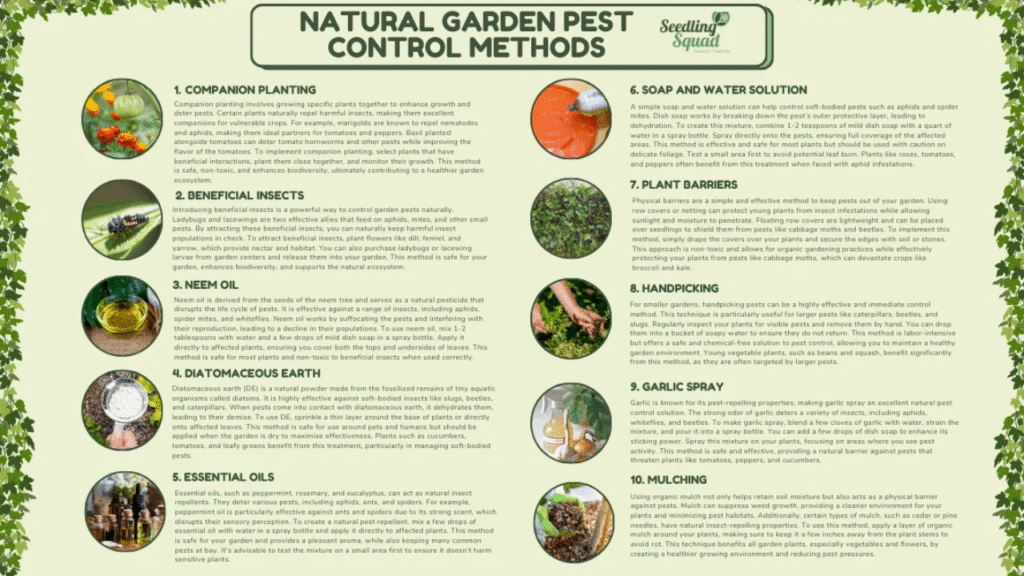
In the pursuit of sustainable farming, natural pest control methods have gained renewed importance. Chemical pesticides may offer quick fixes, but they come with environmental and health costs. Instead, two time-tested strategies—beneficial insects and companion planting techniques—are proving to be effective, affordable, and eco-friendly solutions.
This article explores how farmers and gardeners alike can reduce or eliminate chemical inputs by letting nature regulate its own balance through smart planting and insect allies.
Understanding Natural Pest Control
Natural pest control refers to managing pest populations through ecological relationships, rather than through synthetic chemicals. Two cornerstone methods are:
- Beneficial insects: Predators or parasites that naturally feed on pests.
- Companion planting: Growing specific plants together to repel, trap, or distract harmful insects while improving biodiversity.
These methods are essential for organic farming, permaculture, and regenerative agriculture systems.
Why Natural Pest Control Works
| Factor | Impact |
|---|---|
| Ecological balance | Enhances biodiversity, reducing pest dominance |
| Target specificity | Limits impact on non-target species and pollinators |
| Resistance prevention | Prevents chemical resistance buildup in pest populations |
| Soil and water safety | Avoids contamination of natural resources |
| Long-term cost reduction | Reduces input costs over time with self-sustaining systems |
Beneficial Insects: Nature’s Pest Patrol
Introducing or encouraging predatory and parasitic insects in farms and gardens can drastically cut down pest infestations without toxic sprays.
Top Beneficial Insects and Their Targets:
| Beneficial Insect | Pest Targeted | How It Works |
|---|---|---|
| Ladybugs (Ladybirds) | Aphids, whiteflies, mites | Adults and larvae eat soft-bodied pests |
| Lacewings | Aphids, thrips, mealybugs | Larvae feed aggressively on many pests |
| Parasitic Wasps | Caterpillars, beetles, whiteflies | Lay eggs inside or on pests, killing them |
| Hoverflies | Aphids, scales | Larvae are effective aphid predators |
| Praying Mantises | Wide range (even other pests) | Predatory, excellent for mixed pest types |
| Ground Beetles | Slugs, root maggots, cutworms | Hunt pests at soil level during night |
Tip: To attract beneficial insects, plant flowers like dill, fennel, yarrow, marigold, and cosmos, which provide nectar and pollen.
Companion Planting: Strategic Plant Pairing
Companion planting is the art and science of planting crops together that benefit each other through pest repulsion, nutrient sharing, or spatial efficiency.
Common Companion Planting Techniques:
- Repelling pests: Some plants emit scents that deter insects.
- Trap cropping: Lure pests away from the main crop to sacrificial plants.
- Attracting beneficials: Certain flowers bring in predators and pollinators.
- Allelopathy: Plants release natural chemicals into the soil to suppress pests or weeds.
Examples of Companion Planting:
| Crop | Companion Plant | Benefit |
|---|---|---|
| Tomatoes | Basil, marigold | Repels hornworms, attracts pollinators |
| Cabbage | Nasturtium, thyme | Deters cabbage moths and aphids |
| Carrots | Onions, rosemary | Repels carrot flies |
| Beans | Corn, marigolds | Physical support and pest control |
| Cucumbers | Radish, tansy | Repels beetles and enhances growth |
| Lettuce | Chives, garlic | Deters aphids and slugs |
Building a Pest-Resilient System
Combining insect allies and smart planting creates a pest-resilient ecosystem that grows stronger over time.
How to Start:
- Assess pest history: Know your farm or garden’s common pests.
- Plan habitat zones: Dedicate space for insectary plants and flowers.
- Diversify crops: Break monocultures to disrupt pest breeding.
- Introduce insects: Purchase or attract key beneficials.
- Monitor regularly: Track plant health and pest levels weekly.
Real-World Impact: Case Studies
| Location | Strategy Used | Outcome Achieved |
|---|---|---|
| Kenya (smallholder farm) | Intercropping maize with beans and marigold | 60% fewer stem borers observed |
| California (vineyard) | Cover cropping with wildflowers | Boosted hoverfly populations, reduced aphids |
| India (organic garden) | Companion planting with holy basil and brinjal | No pesticide use for over 2 years |
| Brazil (coffee plantation) | Release of parasitic wasps | 70% reduction in coffee berry borer |
| UK (urban farm) | Ladybug habitat zones + chive borders | Natural aphid control across crops |
Overview Table: Snapshot of Natural Pest Control
| Element | Description |
|---|---|
| Primary Objective | Reduce chemical pesticide use |
| Methods Involved | Beneficial insects, companion planting |
| Best Practices | Flowering borders, diverse crop layouts |
| Advantages | Eco-friendly, long-term sustainability |
| Challenges | Slower action, requires ecosystem care |
| Ideal For | Organic, regenerative, and small farms |
Challenges and Solutions
| Challenge | Solution |
|---|---|
| Slow results | Start early in the season and combine methods |
| Predators leaving the area | Provide habitat and continuous floral resources |
| Pest outbreaks in monocrops | Integrate mixed cropping or trap crops |
| Misidentification of insects | Use field guides or consult local ag extension |
The Future of Pest Control Is Biological
As regulations tighten around synthetic pesticide use and consumer demand grows for chemical-free produce, natural pest control is becoming essential. It promotes not only healthy crops but a thriving ecosystem that restores balance and resilience to the land.
3 One-Line FAQs
Can natural pest control completely replace pesticides?
Yes, in many systems, especially small to medium-sized farms using integrated methods.
How do I attract beneficial insects to my farm?
Plant nectar-rich flowers like marigold, dill, cosmos, and yarrow around your crop zones.
Does companion planting improve crop yield?
Yes, by reducing pest stress and improving soil and pollinator interactions.
Let your garden be a battlefield where nature wins. Through strategic planting and bug partnerships, you can grow healthier food while restoring the health of your soil and surroundings.

